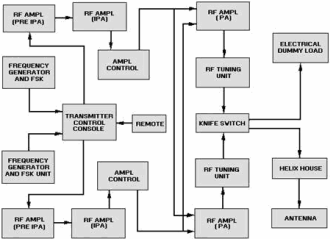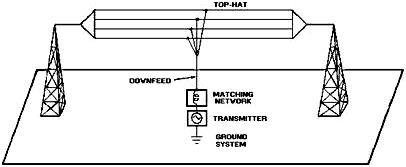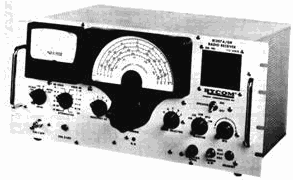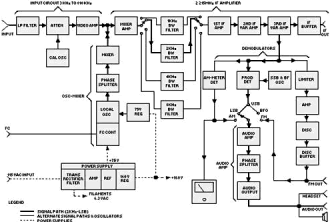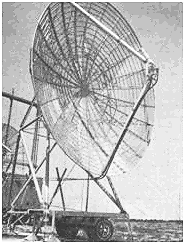Radio-Frequency Communications Principles
|
||||||||||||||||||||||||||||||||||||||||||||||||||
NEETS Module 17 − Radio−Frequency Communications Principles Pages i, 1−1, 1−11, 2−1, 2−11, 2−21, 2−31, 3−1, 3−11, 3−21, 3−31, 3−41, 4−1− to 4−10, 4−11, 5−1, 5−11, Index Chapter 5 Introduction to Miscellaneous Communications Systems and Equipment Learning Objectives Upon completion of this chapter you will be able to: 1. Describe the basic operation of communications systems that operate at medium frequencies and below. 2. Describe the basic microwave line-of-sight communications system. 3. Describe the basic tropospheric scatter communications system. 4. Describe the objective/purpose of the naval tactical data system (NTDS). 5. Describe the naval tactical data system (NTDS) data transmission subsystems in terms of links. 6. Explain the various applications of portable communications equipment. 7. Define the term laser. 8. Describe the basic theory of operation of lasers 9. Describe the possible applications of lasers in communications. Introduction In the previous four chapters we've looked at communications equipment and systems that were used in several frequency ranges. Some have had many applications. In this chapter you will look at systems used in some portions of the RF spectrum that have not been covered in detail. We will also discuss the naval tactical data system (NTDS), which operates in the high-frequency and ultrahigh-frequency regions. Various portable communications equipment used in the military and an introduction to the laser and its uses in communications are included. Some of the applications presented are fairly new to the military community. Systems As discussed in chapter 1, the frequency range from elf to SHF is from below 300 hertz up to 30 gigahertz. The first area we will cover is the lower frequency bands (medium frequency [mf] and below). You will then get a look at the microwave region and the high-frequency and ultrahigh-frequency range as it pertains to the naval tactical data system (NTDS). MEDIUM Frequency and BELow Most of the receivers and transmitters that you will see used in the mf portions of the RF spectrum and below are very similar in design. In chapter 1 we discussed the operational uses of the equipment; now let's look at the equipment itself. Equipment items covered in this and other chapters are meant to be merely representative of equipment that may be encountered in naval communications. No attempt will be made to include all of the possible equipment or equipment configurations. Transmit Equipment You should realize the transmitters used in bands of medium frequency and below are similar to those you studied in chapter 2. In other words, a transmitter used in one frequency range is basically the same as one used in another range. However, there are some differences. Two of the differences are component size and the use of a technique called Doubling Up. The components used in bands of medium frequency and below are much larger physically than the ones previously discussed. This is because of the higher operating voltage and current levels required to produce the very high-powered RF outputs needed for the uses covered in chapter 1. a given resistor used in an hf application may be rated at 1/2 watt, whereas the same resistor used in a lower frequency application would probably be rated in tens or even hundreds of watts. A block diagram of a doubled-up transmitter is shown in figure 5-1. Remember, bands of medium frequencies and below are used almost exclusively for broadcast and are on the air continuously. Doubling up increases reliability. As you can see, two transmitters are located in the same equipment cabinet. This allows you to quickly transfer circuits if one should fail. This dual installation also allows both amplifiers to be used together to double the output power. When you use this application, you sacrifice the doubling-up capability of only the power amplifier. All the other components are still available as backups. Let's go through figure 5-1 and describe the block functions. The frequency generator part of the frequency generator and FSK block is an oscillator. It provides the carrier frequencies for the CW mode. The FSK part is a Frequency Synthesizer (a frequency source of high accuracy). It makes both the mark and space frequencies from a very stable clock oscillator. The keying pulses determine which FSK frequency the keyer chooses to transmit. This signal is then sent to the transmitter control console where it is distributed to the first RF amplifier. This amplifier is referred to as the preliminary intermediate-power amplifier (pre-IPA). The pre-IPA uses linear, untuned, push-pull, RF amplifiers to provide amplified RF to drive other RF amplifiers. The pre-IPA output goes to the intermediate power amplifier (IPA). The IPA receives the pre-IPA output, amplifies the signal, and drives other selected power amplifiers. The IPA is a single-stage, untuned, linear, push-pull, RF circuit that uses water and forced-air cooled tubes. Signals are then sent through the amplifier control, where they are used for signal monitoring purposes before being applied to the final RF amplifier (pa). The pa amplifies the signal to the final desired power level. The pa also contains variometers (variable inductors) for coupling. This coupled output is fed to the RF tuning unit. The RF tuning unit consists of variable oil-filled capacitors and a fixed inductor for frequency tuning. The signal is then sent to a knife switch. This switch simply routes the signal to the Dummy Load or the antenna by way of the Helix House. (A dummy load is a nonradiating device the absorbs the rf and has the impedance characteristics of the antenna.) The dummy load is impedance matched to the pa. It allows testing of the pa without putting a signal on the air. When the equipment is in an operating mode, the dummy load is not used. The helix house is a small building physically separated from the transmitter location. It contains antenna loading, coupling, and tuning circuits. The main components consist of a Helix (large coil) and variable inductors. The signal is fed from the helix directly to the antenna. Sometimes two antennas are used.
Figure 5-2 - Simplified VLF transmitting antenna.
Figure 5-3 - Cutler, Maine antenna installation. Figure 5-4A - Triatic type antenna. Figure 5-4B - Triatic type antenna.
Figure 5-5. - Typical VLF to mf receiver. Figure 5-6 - Receiver block diagram. Antenna designs vary with the amount and type of land available, desired signal coverage, and bandwidth requirements. Figure 5-2 shows a simplified transmit antenna. The Navy uses TOP-HAT (flat- top) capacitive loading with one or more radiating elements. Typical top hat antennas consist of two or more lengths of wire parallel to each other and to the ground, each fed at or near its mid point. The lengths of wire are usually supported by vertical towers. These antennas may take many shapes. The matching network shown is in the helix house. Figure 5-3 shows the installation at the naval communications unit in Cutler, Maine. The Navy has several of these types of installations. They are used primarily for fleet broadcasts and have power outputs in the .25- to 2-megahertz range. You should notice the transmitter, the location of the helix houses, and the dual antennas. You should also notice the transmission line tunnel. It is underground and over a half-mile long. Figure 5-4, view (A) and view (B), shows another antenna configuration. This array of monopoles (quarter-wave, vertically polarized stubs) is referred to as a TRIATIC antenna. a triatic antenna is a special form of a rhombic-arranged monopole array. This type of array is designed to transmit from a particular location. Triatics are all basically the same but have some design differences at each site. The physical differences compensate for differences in terrain. Now that we have looked at the transmit side, let's look at the receive side. Receive Equipment The receiver you will study here is fundamentally the same as those we covered in chapter 2. a receiver used in this frequency range is about the same electrically as one used in any other range. Figure 5-5 shows the receiver we will discuss. It is a highly sensitive, special purpose receiver because it is capable of splitting-out multiplex signals for detection and reproduction. This receiver covers the frequency range of 3 kilohertz to 810 kilohertz in five bands. It will receive most types of signals, including AM, CW, SSB, FM, and FSK. All operator controls are on the front panel, and a speaker and headset jack permit monitoring. Our receiver has five basic stages excluding the power supply. With the exception of a video amplifier in place of an RF amplifier, the circuits perform the functions normally associated with a typical receiver. Figure 5-6 is a block diagram showing the signal paths of the receiver. The input stage consists of a low-pass filter, an attenuator, a calibration oscillator, and a video amplifier. The low-pass filter passes input frequencies below 900 kilohertz. These frequencies are passed to the attenuator, which sets the signal to the proper level to drive the mixer. This minimizes noise and distortion. The calibration oscillator produces a 250-kilohertz output. It is used to calibrate the receiver level and to check for tuning dial accuracy. The input signal is direct-coupled from the attenuator to the video amplifier. This amplifier is a broadband, constant-impedance driver for the mixer. The oscillator-mixer stage consists of a mixer, phase splitter, local oscillator, and frequency control circuits. A Hartley configuration is used for the local oscillator. The oscillator output is equal to the tuned frequency plus 2.215 megahertz. Two voltage-variable capacitors are used in the local oscillator to stabilize small frequency variations. a phase splitter is used to drive the mixer diodes into conduction during half of the local oscillator cycle. The mixer circuit uses the diodes to heterodyne the input signal with the local oscillator signal from the phase splitter. The diodes short the signal to ground during half the local oscillator cycle. The IF amplifier stages consist of the mixer amplifier, four selectable bandwidth filters, three IF amplifiers, and an IF buffer amplifier. The output of the mixer is directly coupled to the mixer amplifier. The IF signal is then directed through one of four bandwidth filters to the first IF amplifier. The signal proceeds to the second and third IF amplifiers for amplification before demodulation. An IF buffer amplifier is used to pass the IF to the IF OUT jack and to isolate this jack from the rest of the circuitry. Three demodulators are used in this receiver. They are the AM detector, product detector, and FM detector. The AM detector is used to demodulate AM signals. The product detector demodulates SSB, CW, and FSK signals, and the FM detector demodulates FM signals only. An output from the FM detector is provided to the FM OUT jack. This FM output may be used for recording or detailed analysis. The output from the selected demodulator is amplified by the audio amplifier and presented simultaneously to the Headset jack, Audio OUT terminals, and the speaker. You should note that this receiver, as with most others, requires no other special equipment. It uses a standard DF loop or a whip antenna. If it is installed in a submarine, a trailed, (towed) long-wire antenna may be used. Microwave Communications systems in the 1 gigahertz to 10 gigahertz portion of the radio frequency spectrum use line-of-sight propagation. Propagation takes place in the lower atmosphere (troposphere). It is affected by factors such as barometric pressure, temperature, water vapor, turbulence, and stratification (forming of atmospheric layers). A typical microwave transmitter includes an exciter group, a modulator group, a power amplifier, and power supplies. The transmitter usually has a power output of about 1 watt. When a higher output is required (about 5 watts), a traveling-wave tube (TWT) is used as the amplifier. (A TWT is a high-gain, low- noise, wide-bandwidth microwave amplifier. It is capable of gains of 40 decibels or more, with bandwidths of over an octave. The TWT was discussed in chapter 2 of NEETS, Module 11, Microwave Principles.) a typical microwave receiver contains an RF-IF group, local oscillator, demodulator, and amplifier. Both transmitters and receivers contain special circuits because of the high operating frequencies and critical frequency stability requirements. Line-of-Sight System A line-of-sight (los) microwave system consists of one or more point-to-point hops as shown in figure 5-7. Each hop is designed so that it can be integrated into a worldwide communications network. Los systems have many characteristics. In these systems, propagation is only affected by changes in the troposphere. The distance between microwave system hop points ranges from 50 to 150 kilometers (31 to 95 statute miles). These systems are capable of handling up to 600 4-kilohertz voice channels and can also transmit television. These signals can usually be transmitted with less than 10 watts of power. Both the transmit and receive antennas are horn-driven paraboloids that provide high gain and narrow beam widths. In some applications, as shown in figure 5-8, plane reflectors are used with the paraboloids. These systems are very reliable. They are designed to operate over 99 percent of the time. These systems are well adapted to multichannel communications and closed circuit television.
Figure 5-8 - Parabolic antenna and passive reflector combination. Now let us take a look at another system. It is called the tropospheric-scatter microwave system. But first, you may want to review tropospheric propagation in NEETS, Module 10, Introduction to Wave Propagation, Transmission Lines, and Antennas. Tropospheric Scatter System A tropospheric-scatter (tropo-scatter) microwave system gets results similar to those of the line-of- sight system. It does it in a different way. The los system uses towers to relay information.
Figure 5-9 - Mobile 30-foot tropospheric-scanner antenna. The tropo system uses the turbulence in the layer between the troposphere and the stratosphere to bounce signals back to earth. This method provides several hops and communications beyond los. The propagation reliability and communications capability is the same. The transmission range is up to 800 kilometers (500 statute miles). Transmitter output power may be up to 75 kilowatts depending on the operational requirements. The antennas are horn-driven paraboloids and may be as large as 50 to 60 feet in diameter. Figure 5-9 shows a typical tropospheric-scanner antenna. Remember that hf has a hop distance (skywave) of about 1,400 miles; the distance of one hop for a line-of-sight system is between 31 and 95 miles. The tropospheric-scatter system conveniently fills the gap between these distances. Both of these systems are used ashore. You're now going to get a look at a shipboard data information exchange system. Q1. What is a dummy load? Q2. What is the function of a product detector? Q3. What is the frequency range of the mf band? Q4. Microwave systems use what portion of the atmosphere? Q5. What is the voice channel capacity of an los communications system? Q6. What is the one-hop transmission range of a tropospheric-scatter system? NAVAL TACTICAL DATA System In recent years, the Navy has introduced several new highly technical and effective combat weapons systems. However, these weapons systems did not solve the basic combat command problems that confront our Navy. In combat, a fleet continues to be involved in close-range offense and defense. During close-range combat, the shipboard combat information center (CIC) is involved in complex tactical situations. These situations require intelligent and highly important decisions. Each decision has to be made in a short period of time. You will find the speed at which these combat situations must be solved is inconceivable to someone thinking in terms of typical CIC operations of the recent past. Therefore, the NTDS was developed by the U.S. Navy as a command tool for commanders in tactical combat situations. Objectives The naval tactical data system (NTDS) is based on the interaction of humans and machines. The NTDS helps coordinate fleet air defense, antisubmarine warfare, and surface defense operations. Through
Posted November 5, 2021 |
||||||||||||||||||||||||||||||||||||||||||||||||||
